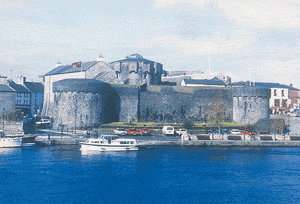
 |
The Battle Of Athlone

|
On 6th June General Godart Van Ginkel and his army marched from Mullingar reaching Ballymore the next day. Ballymore was about half way to Athlone and it was here that the opening shots of the 1691 campaign were fired. In the war between James and King William the possession of Athlone was considered of the greatest importance, and it consequently sustained two sieges, the first William III. in person, which failed, and the second by general Godart van Ginkel, who, on the 30th of June 1691, in the face of the Irish, forded the river and took possession of the town, with the loss of only fifty men. Ginkel was subsequently created Earl of Athlone, and his descendants held the title until it became extinct in 1844. Colonel Ulick Burke with about a thousand men had fortified an old Norman motte defending a peninsular and surrounded by water or bog. The intention was to try to hold up the Williamite forces of Ginkel for as long as possible. This was an impossible task and the heavy artillery of Ginkel's force soon defeated the Jacobites. Ginkel's force reached Athlone on the 19th June. Athlone itself was made up of two walled towns with the river Shannon running between them. The town on the Leinster side of the river was known as the English Town and the other, on the Connaught side of the river was known as the Irish Town. Ginkel's artillery spent the first day shelling the walls eventually breaching the wall in the Bastion near the North Gate. At daybreak the next day the barrage continued until the breach was some thirty yards wide. Some twelve thousand cannonballs were actually fired during the entire siege. The main assault started at 5pm - Three hundred grenadiers followed by pioneers were the first through the breach. Next through were four Regiments of Foot - commanded by Hugh Mackay, who were to fan out and secure the Leinster town. The defenders had damaged the bridge across to the Connaught side hoping that this would stop the Williamites. At this time St Ruth arrived with the main Jacobite army and they camped some two miles from the besieged town. Lieutenant General d'Usson along with the Scot, Major General Maxwell to command the defence of the town. Just over the remains of the bridge stood the castle and upstream the stout Connaught Tower. Before the main assault, by Ginkel, it was decided that these two fortified buildings must be neutralised. Therefore a week long barrage of artillery shells was mounted until finally the castle and the tower were just heaps of rubble. This left the way open for a full frontal attack and on 26th June it started. Williamite troops advanced and the Sappers managed to repair the damaged bridge and so to enable other troops to cross and continue the fighting. Before the attack could commence however, twenty or so of Major Maxwell's soldiers managed to advance onto the bridge and destroyed the Williamite attackers temporary repairs. On 29th June an attack was planned to take place at the ford just below the bridge but this was abandoned when preparations were seen and the Jacobites were reinforced from St Ruth's main army. However at six pm on the thirtieth of June the main attack started, some two thousand men under the command of Colonel Gustavus Hamilton along with the Inniskilling Grenadiers plunged into the river. Once over the river these men under the overall command of Talmash fanned out and, due to the fact that the Jacobites broke and ran captured the whole town within an hour. Athlone was now in the hands of the Williamite forces. |